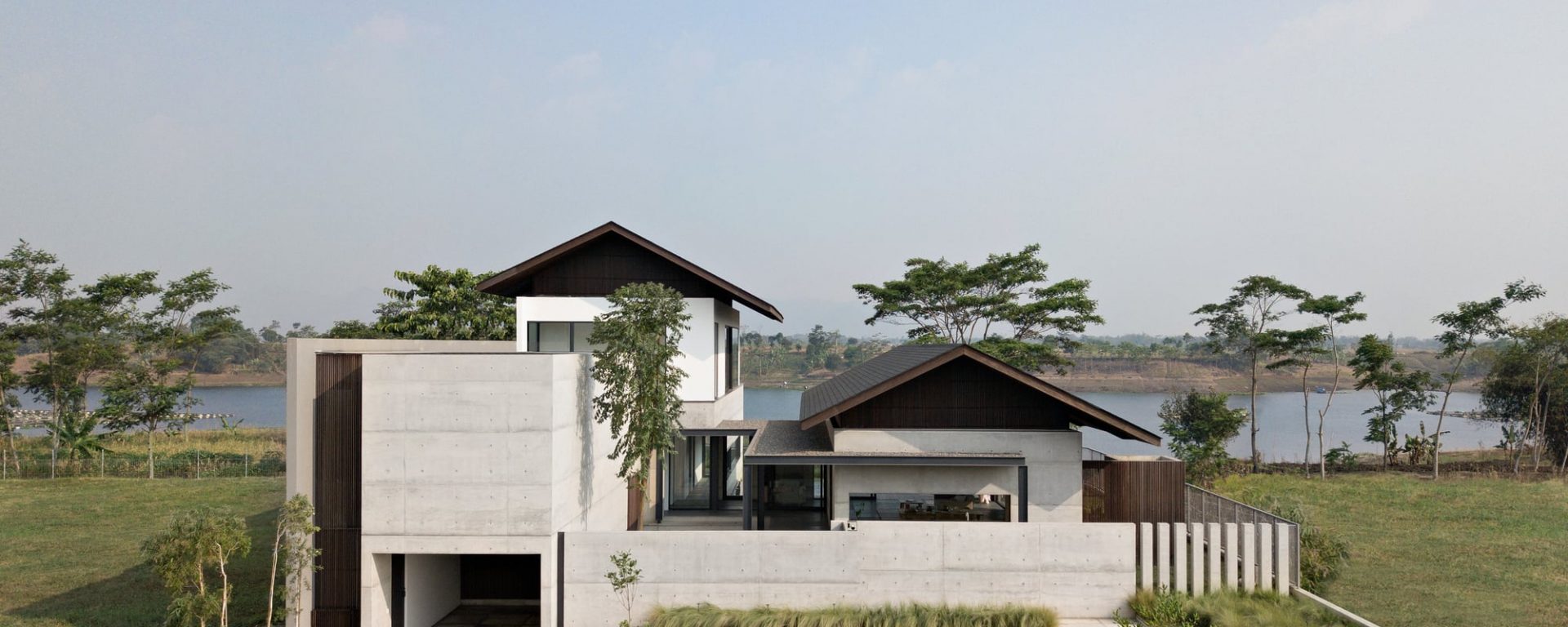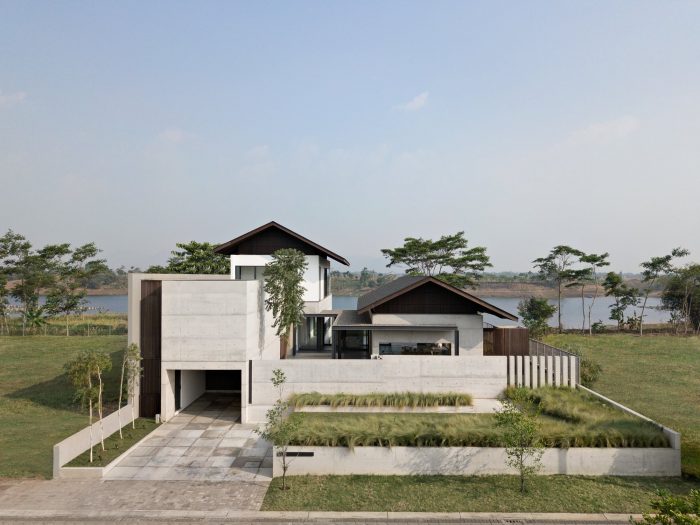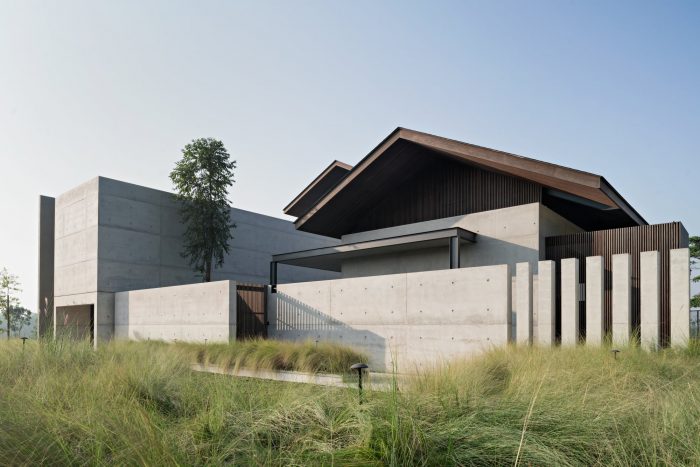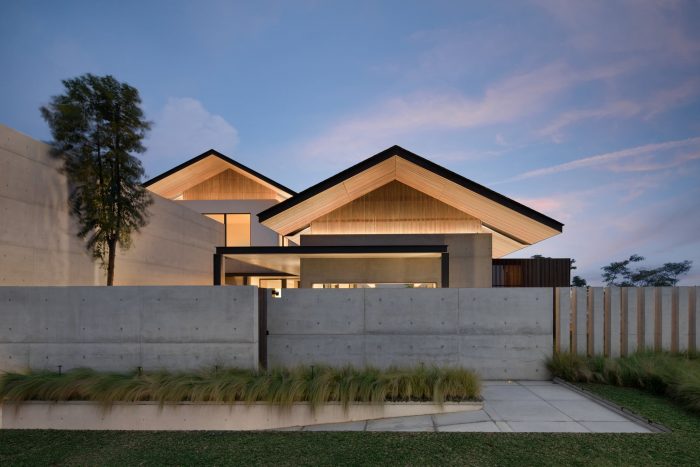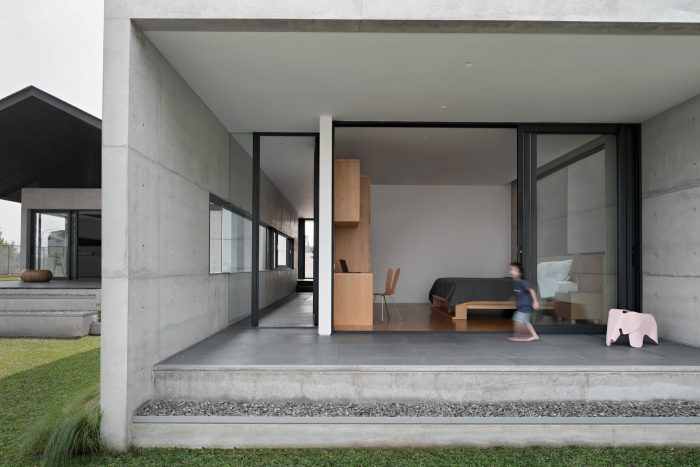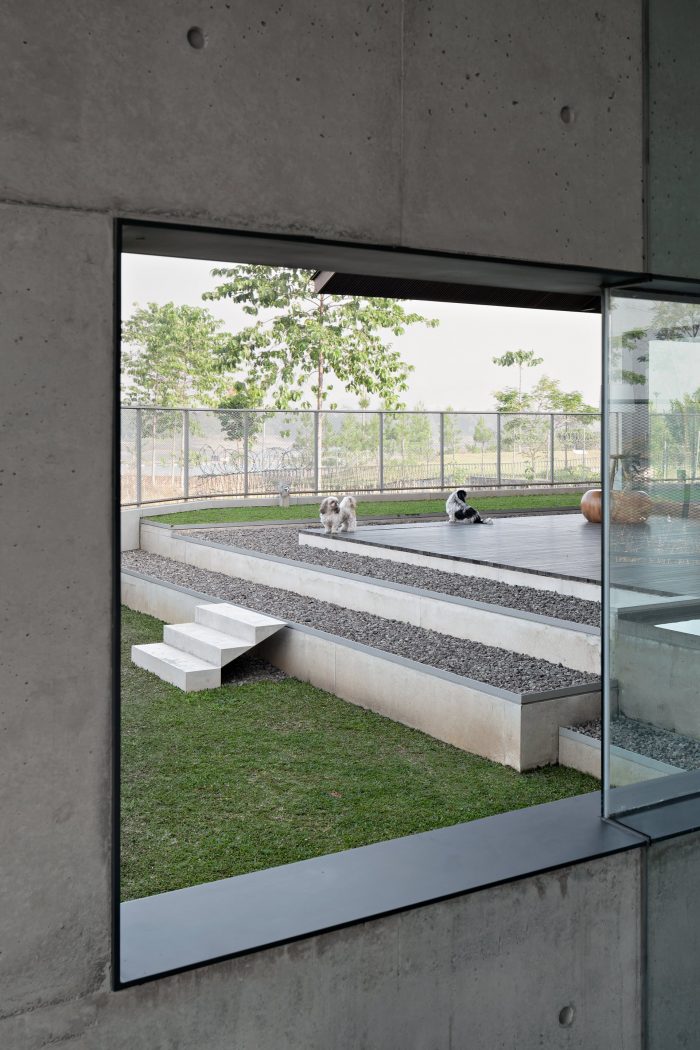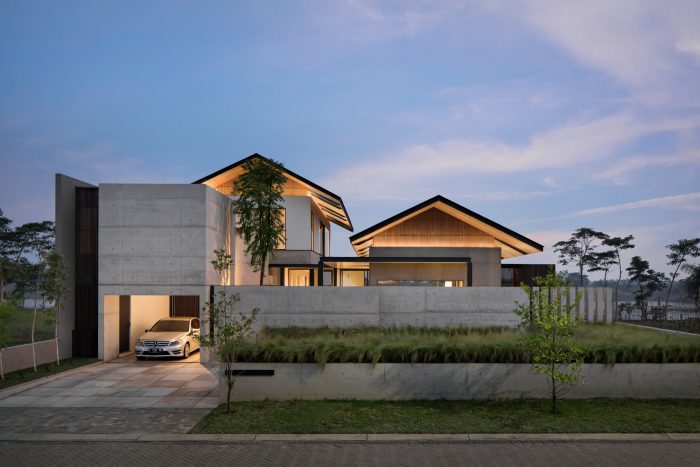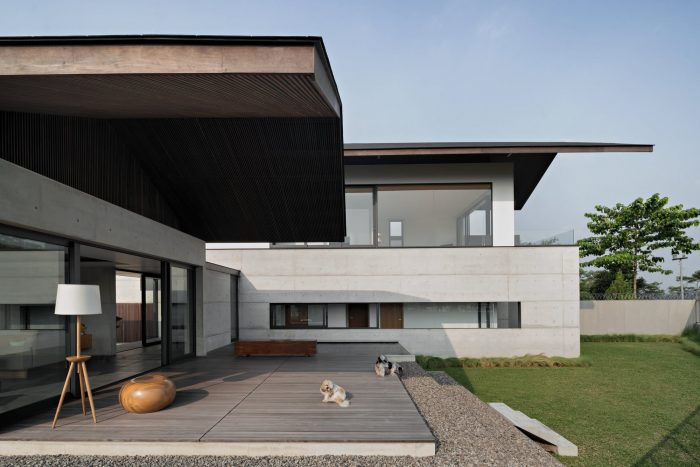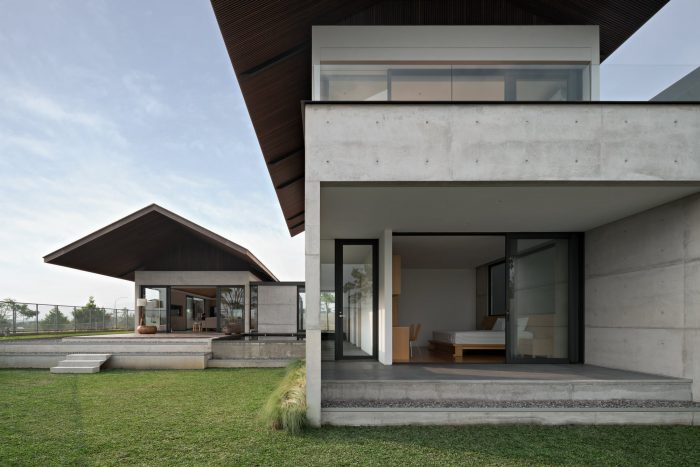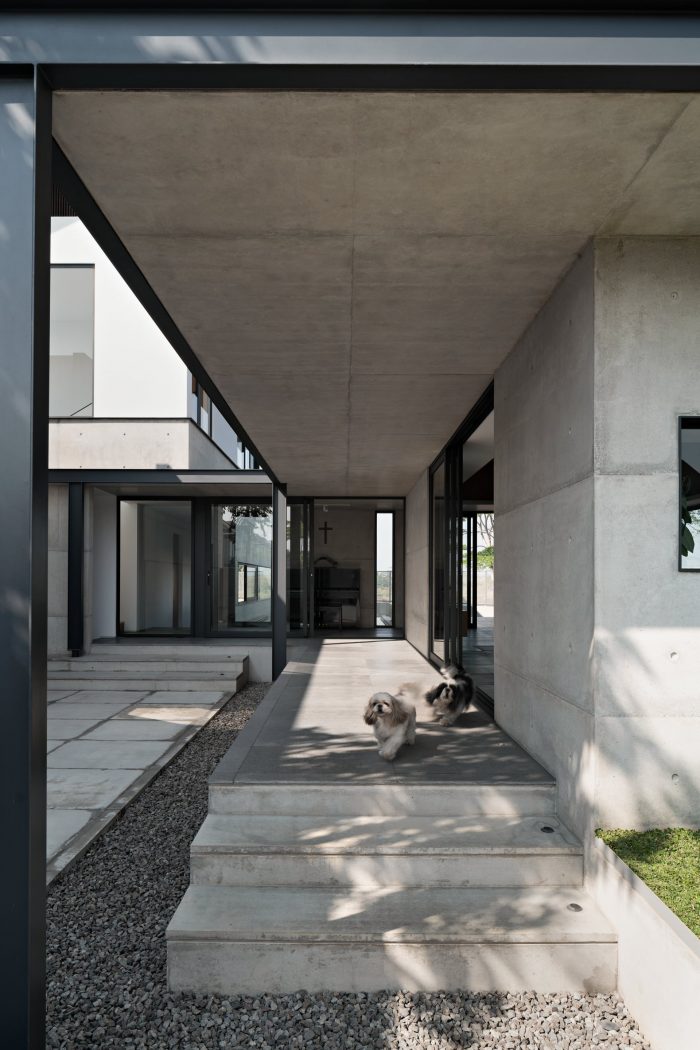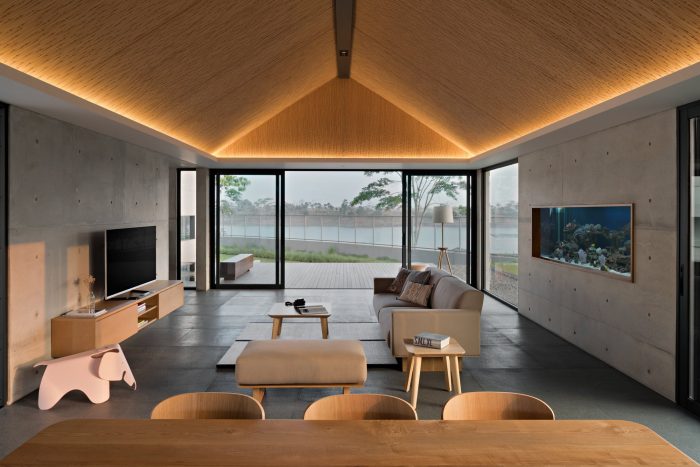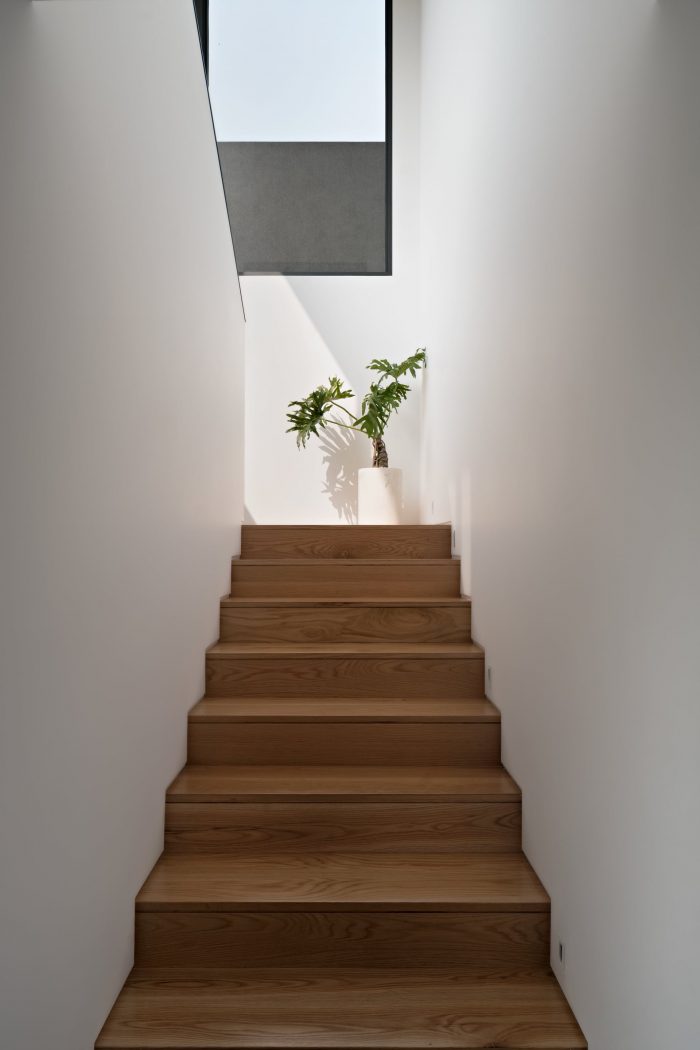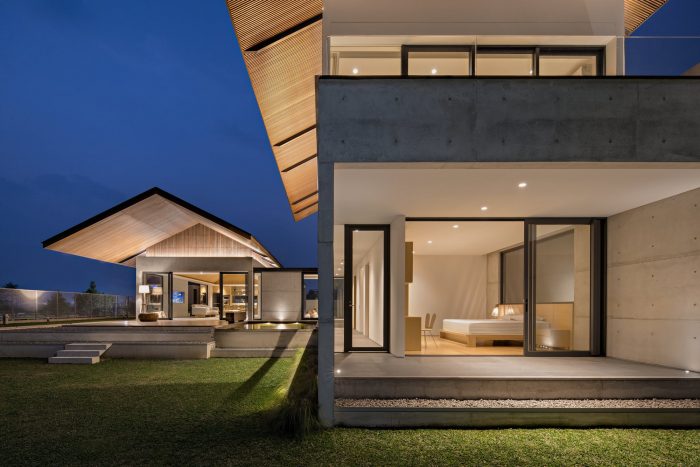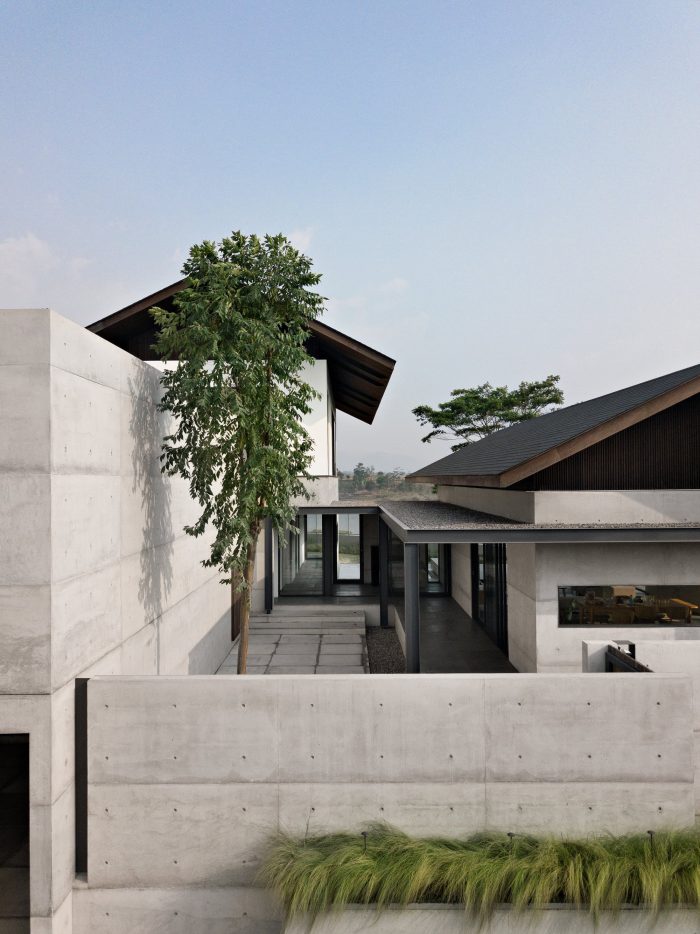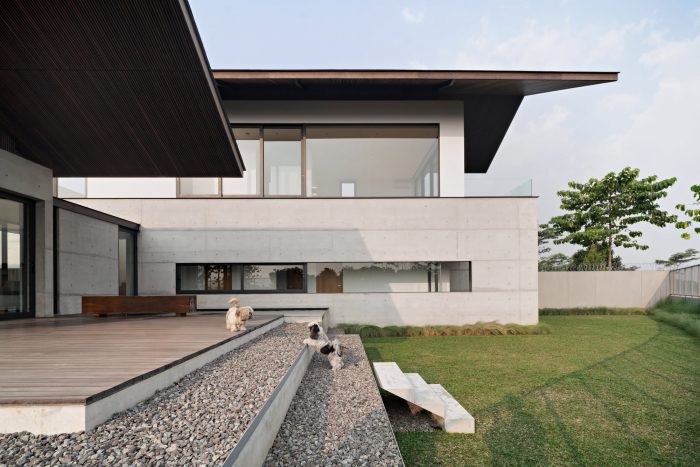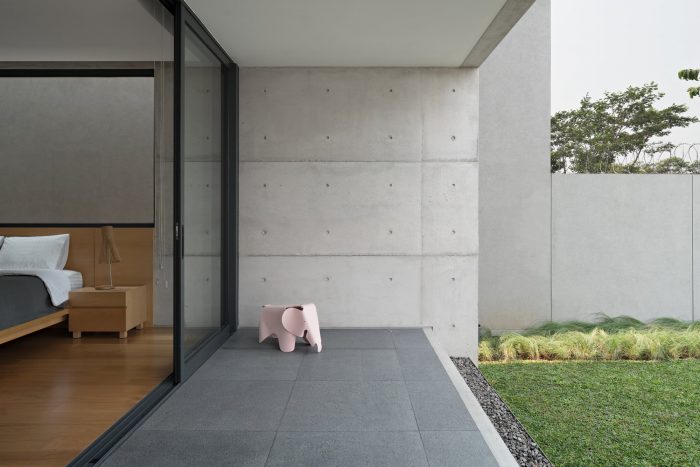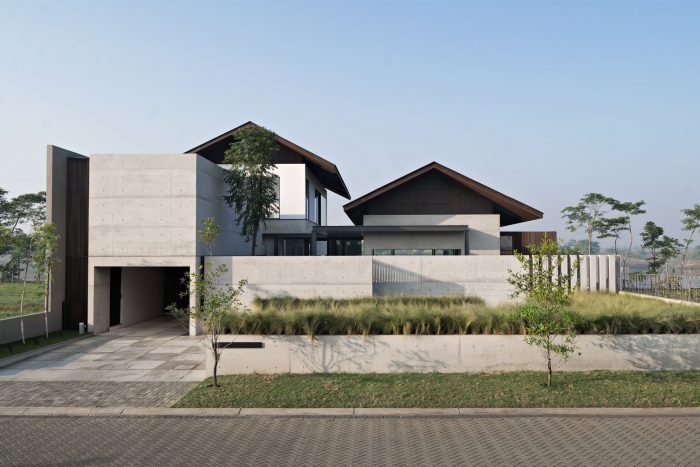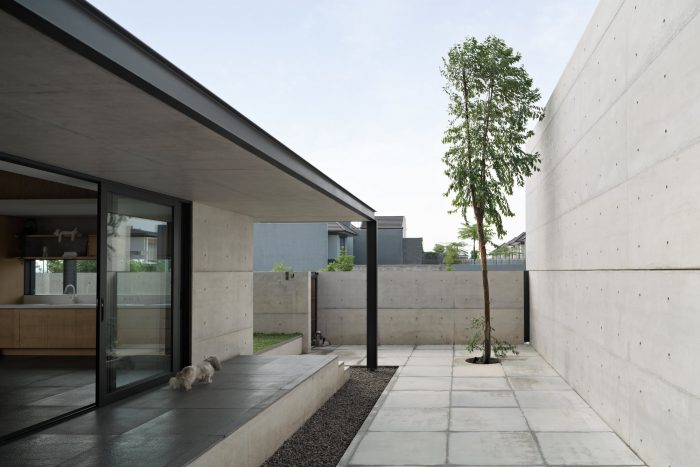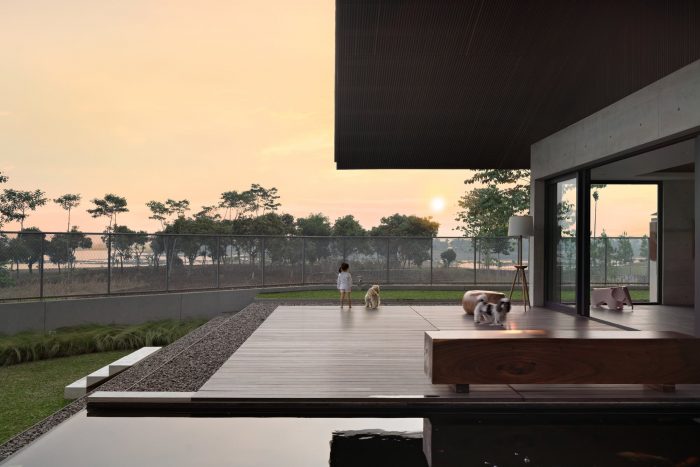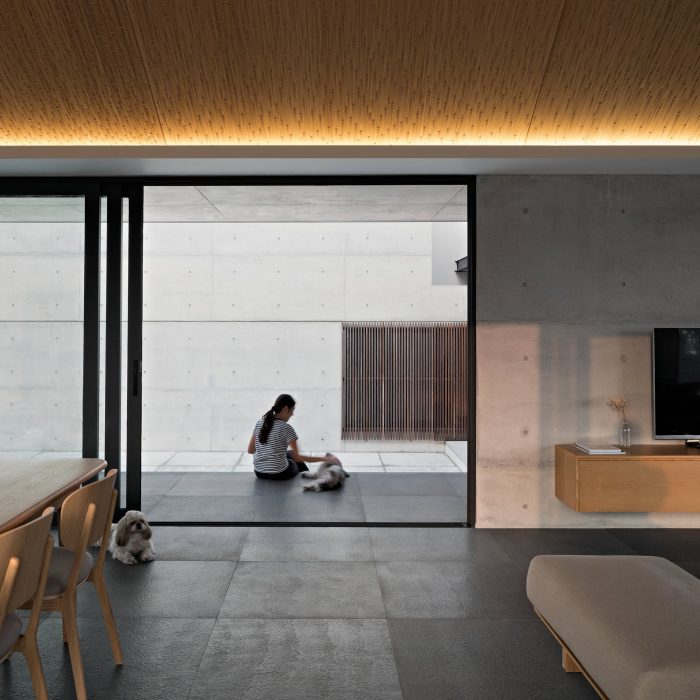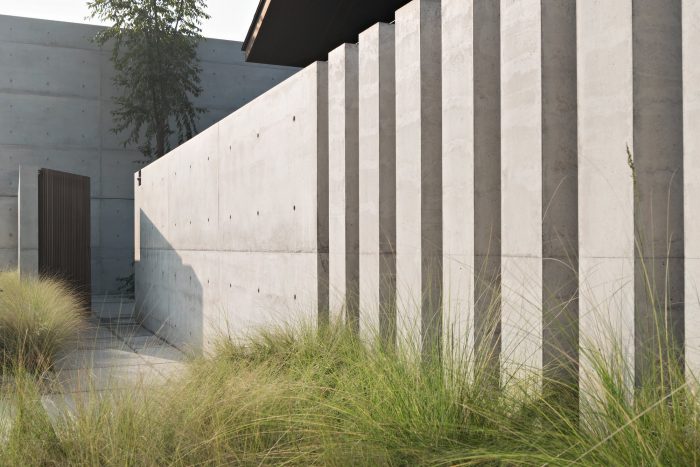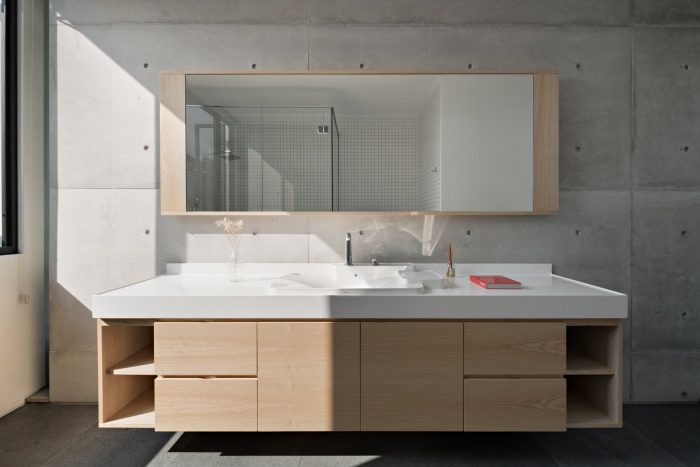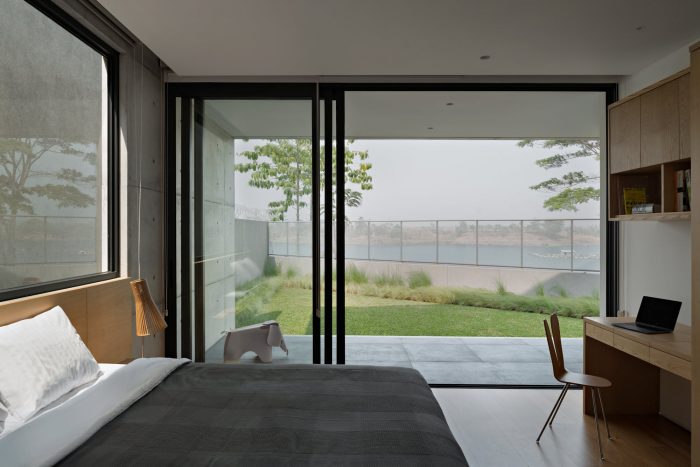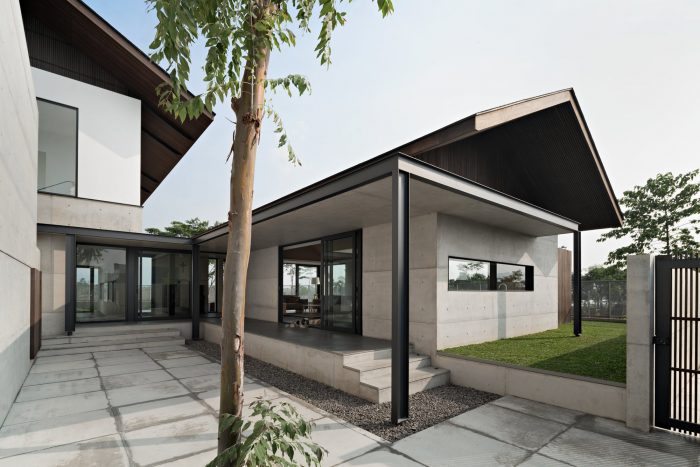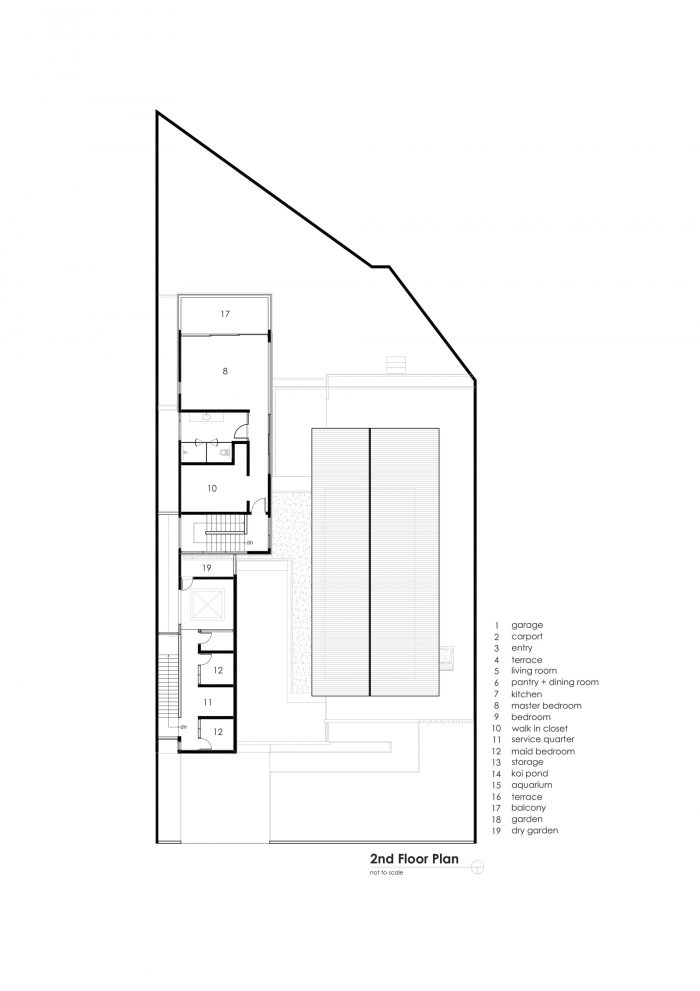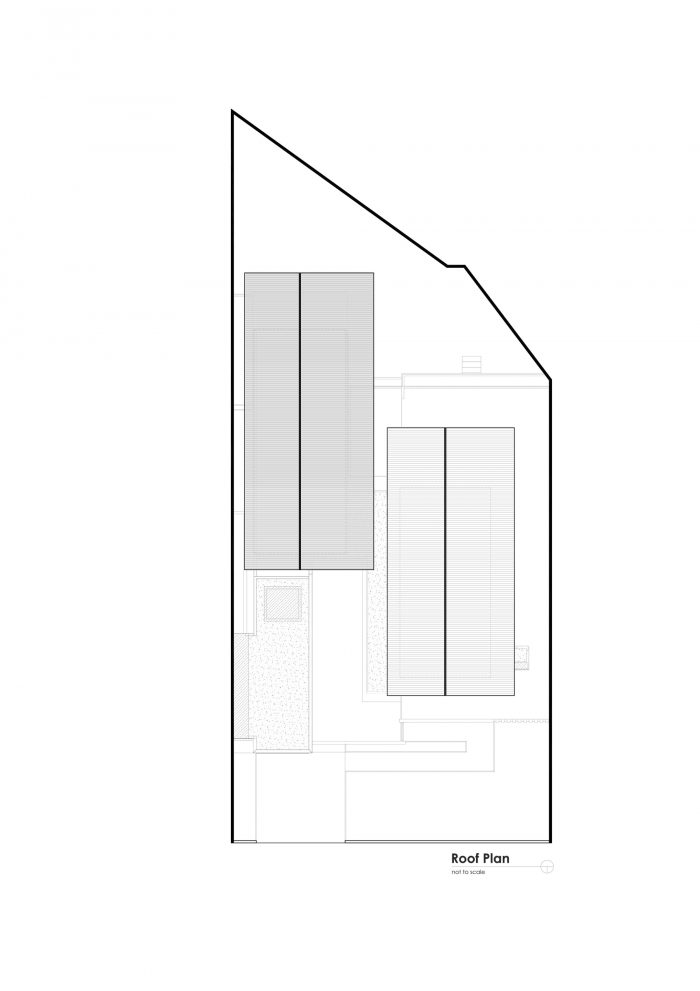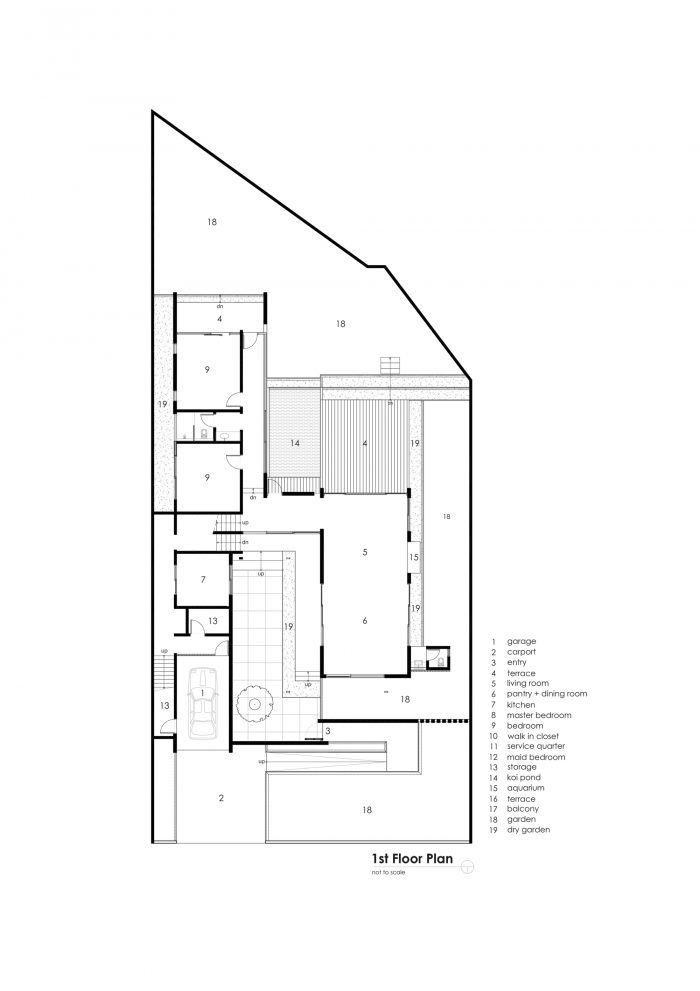乍一看,”Iyashi House “激起了参观者的兴趣,让他们闭上眼睛,放下数字的干扰,不理会周围的景观和其他建筑的精巧,哪怕只是一瞬间,这就是房子的特点。在没有视觉维度的情况下,人们可以开始感知空间内新出现的寂静之声,并辅以遥远的郊区自然色调。柔和的微风在房子里跳动,使室内和室外的唯一有形分界线被拴在人们赤脚下的材料和纹理的转换上。日语中的 “Iyashi “一词有治愈、恢复活力或宁静的意思。这个房子被设计成一种家庭圣地,沉浸在安静、自然光和如画的风景中。Iyashi House “是一个有3个卧室的私人住宅,坐落在印度尼西亚万隆一个宁静的湖边郊区,被设想为一对夫妇的退休之家,也是他们的大家庭和朋友聚会的地方。
At first glance, ‘Iyashi House’ provokes its visitors to close their eyes, let go of digital distractions and disregard, if only for a moment, the views of the surrounding landscape and otherwise architectural finesse that characterizes the house altogether. In the absence of the visual dimension, one can begin to perceive the emerging sound of silence within the space, complemented by distant undertones of suburban nature. A sensation of soft breeze pulsates through the house, leaving the only tangible demarcation of indoor and outdoor tethered to the material and textural transitions beneath one’s bare feet. The Japanese word ‘Iyashi’ bears the meaning of healing, rejuvenation or sense of serenity. This house is designed as a kind of domestic sanctum, immersed in silence, natural light and picturesque scenery. ‘Iyashi House’ is a 3 bedroom private residence nestled in a serene lakeside suburb of Bandung Indonesia, conceived as a couple’s retirement home and a place of gathering for their extended family and friends.
房子被围墙缓缓掩盖,前面是一条短的上升通道,被Alang Alang草地所包围。主入口走道通向一个内部庭院,安装了定制的预制混凝土砖,并以一棵常青树作为点缀。建筑的特点是完美的现浇混凝土、亚光钢支架和铁木屋顶天花板的鲜明并列。引人注目的日本式屋顶通过向内偏移建筑物的混凝土墙而变得更加突出,并由钢结构支撑,使其具有 “半浮动 “的外观和修长的悬臂。整体设计由两个朝南的、相互连接的、斜屋顶的建筑组成,它们彼此平行,还有一个朝北的、平屋顶的建筑,包含服务设施和一个开放的汽车库。整体空间的顺序进行了环境优化,以适应当地的巽他气候,尽量减少对持续维护和昂贵的空调的需求。
The house is gently concealed by perimeter walls, preceded by a short ascending walkway that is framed by Alang Alang grass. The main entrance walkway leads into an interior courtyard, fitted with bespoke, pre- fab concrete tiles and embellished with a single evergreen tree. The architecture features a sharp juxtaposition of perfectly finished cast-in-situ concrete, matte steel supports and Ironwood roof ceilings. The striking Japanesque roofs are accentuated by an inward offset from the buildings’ concrete walls and bolstered by a steel structure that enables their ‘semi-floating’ appearance and elongated overhangs. The overall design is composed of two south facing, interconnected, pitched roof buildings running parallel to each other and a north facing, flat roof, building containing service facilities and an open car garage. The overall sequence of spaces were environmentally optimized to fit the local Sundanese climate, minimizing the need for constant maintenance and costly air conditioning.
左边的建筑是一个双层的私人生活区,包括两间客房,地面上有共用的浴室设施,第二层是一间主卧室,套房浴室和阳台。右边的建筑是一个单层的空间,包括一个开放式的厨房、用餐区和宽敞的客厅,流向室外的露台和草地。露台的顶部是一个四米长的悬臂式悬架,它框住了湖边的视野,并产生了一种漏斗效应,将景观吸引到房子里。
The left building is a double tiered private living quarters consisting of two guest bedrooms with shared bathroom facilities on the ground level and a master bedroom, en-suite bathroom and balcony on the second level. The right building is a single tiered space consisting of an open plan kitchen, dining area and spacious living room that flows into an outdoor terrace and grass lawn. The terrace is crowned with a four meter long, cantilevering overhang that frames the lakeside vista and generates a kind of funneling effect that draws the landscape into the house.
此外,在这个例子中,室内和室外的关系,通过从在客厅大厅铺设泥土的、令人愉快的崎岖不平的安第斯岩石,到用美丽的 “太阳吻 “乌林木(也称为铁木)铺设的大露台,得到了明显的阐述。这仅仅是该项目一系列材料构成的一个例子,这些材料都是经过精心挑选的,并共同设置了自然风化的痕迹,在时间的力量下优雅地老化。
Furthermore, the relationship between indoor and outdoor in this instance, is distinctly articulated through the shift from the earthy, pleasantly rugged, Andesite stone tiling the living room hall, to the grand terrace, decked with beautifully ‘sun kissed’ Ulin Wood (also know as Ironwood). This is merely an example of the project’s array of material compositions, carefully chosen and collectively set to age gracefully with hints of natural weathering, marked by the forces of time.
在这个住宅的所有设计细节和建筑元素中,露台也许是建筑的主角,它抓住了房子的本质。因此,其本质或灵魂在于寻求印尼热带生活的室内和室外之间的现代化协同作用。这个概念通过定制的手工编织的藤板进一步阐明,横跨房子的起居室和用餐区的倾斜天花板。Iyashi House “试图直接和间接地探索现代印尼住宅如何综合和反映这个国家与自然的古老关系,作为其工艺、文化和福祉的来源。
Of all design details and architectural elements conceived in this residence, the terrace is perhaps the architectural protagonist’ that captures the essence of the house. Thus, the essence or perhaps the soul lies in the search of a modernized synergy between the indoor and outdoor dimensions of Indonesian tropical living. This notion is further articulated by bespoke handwoven rattan panels spanning across the pitched ceiling of the living and dining area of the house. ’Iyashi House’ attempts to explore, both directly and indirectly, the ways in which a modern Indonesian house can synthesize and reflect upon the nation’s archaic relationship to nature as its source of craft, culture and well-being.
Architects: Pranala Associates
Area : 462 m²
Year : 2019
Photographs :Mario Wibowo Photography
Manufacturers : Hansgrohe, Daikin, Duravit, GAF, MIWA, Mackenzie, YKK Nexsta
Contractor : Bouw Atelier
Landscape : Larch Studio
Lighting Consultant : Lentera Artlighting
Principal Architect : Ronald Pallencaoe, Erick Laurentius, Darius Tanujoyo
Copywriter : Ran Ben-Shaya
Furniture Consultant : Mono Intercraft
Weaving Technology Provider : Byo Living
City : Bandung
Country : Indonesia

